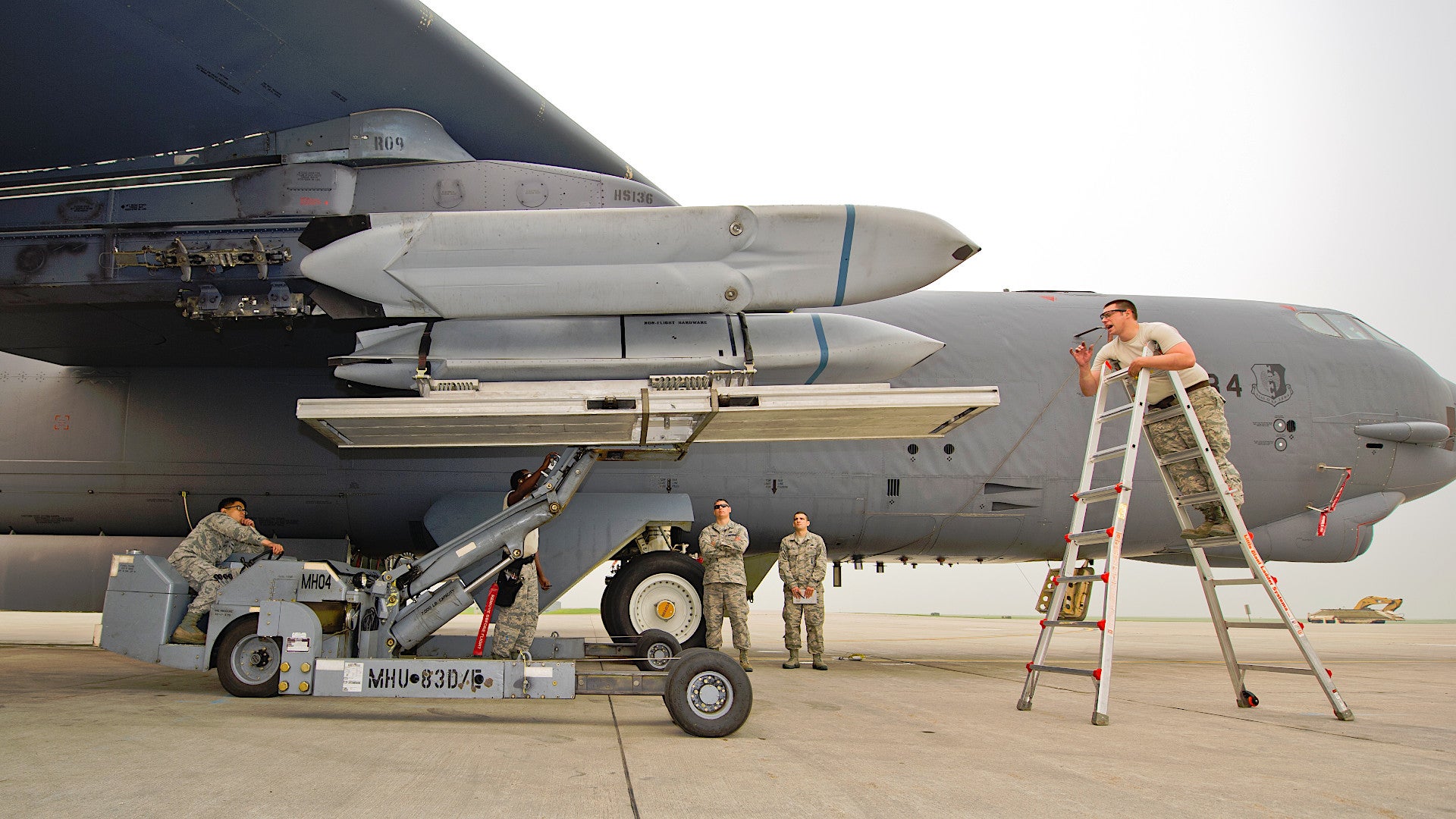The U.S. House of Representatives just passed the latest annual defense policy bill, covering the 2020 Fiscal Year, which eliminates the Congressional requirement for the U.S. Air Force to develop a conventionally armed variant of its future nuclear-tipped Long-Range Stand-Off air-launched cruise missile, or LSRO. It is very likely that this decision is linked to the development of a new extreme-range variant of the AGM-158 Joint Air-Surface Standoff Missile, or JASSM-XR, which will be able to hit targets over 1,000 miles away and is scheduled to be out of testing in 2023. The Air Force also just recently retired the last of its existing AGM-86C/D Conventional Air-Launched Cruise Missiles, or CALCMs, which the conventional LRSO was originally slated to replace sometime after 2030.
The House passed the Fiscal Year 2020 National Defense Authorization Act, or NDAA, on Dec. 11, 2019, two days after the House Armed Services Committee announced that it had agreed to a final version of the bill with their counterparts in the Senate. The Senate will have to now vote on it and, if it passes there, it will head to President Donald Trump’s desk, where he is likely to sign it into law given the strong bipartisan support behind it.
The new NDAA amends pre-existing laws covering the LRSO program to demand only that the Air Force develop a weapon that “achieves initial operating capability for nuclear missions prior to the retirement of the nuclear-armed AGM–86.” The LRSO must still be “capable of internal carriage and employment for nuclear missions on the next-generation long-range strike bomber,” referring to what is now known as the B-21 Raider stealth bomber.
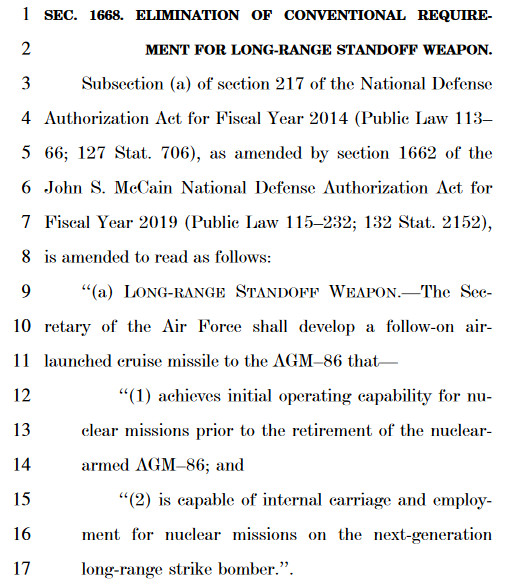
There are few publicly available details about the requirements for the LSRO, which Lockheed Martin and Raytheon are presently competing to build. The missile will have a very stealthy design to make it more survivable against the increasingly threatening integrated air defenses entering service around the world, especially among potential neer-peer opponents, such as Russia and China. This will be the U.S. Air Force’s first stealthy cruise missile to enter service since it retired the state-of-the-art AGM-129A Advanced Cruise Missile (ACM), which The War Zone
recently profiled, in 2012.

The LRSO will also likely include improved guidance and navigation capabilities that can react autonomously to threats in their environment and retain high accuracy even in GPS denied situations. It could also feature a new nuclear warhead. The existing nuclear-armed AGM-86B Air-Launched Cruise Missile (ALCM) carries a single W80-1 variable yield thermonuclear warhead, but are expected to eventually get refitted with upgraded W80-4s. Those same updated warheads could very well find their way into the Air Force’s new air-launched cruise missile, which is expected to begin entering operational service in 2030.
A separate provision of the Fiscal Year 2020 NDAA also requires the Under Secretary of Defense for Acquisition and Sustainment to, in cooperation with the Administrator for Nuclear Security, to provide Congress with a report within three months detailing ways to leverage work on the LRSO program to support the U.S. Navy’s new nuclear-armed Sea Launched Cruise Missile (SLCM) program and to increase commonality between the two weapons. You can read more about the separate SLCM program in this past War Zone piece.
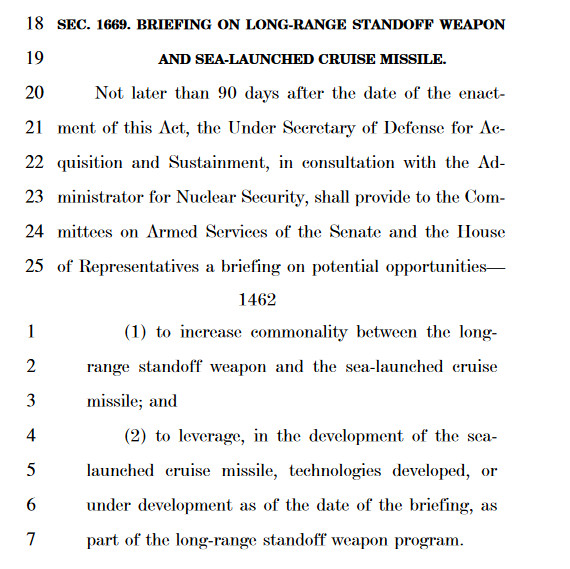
It’s the decision to remove the requirement for a conventionally-armed variant of the LRSO that could have much farther reaching ramifications for other cruise missile programs. It’s worth noting that without the Congressional mandate, the Air Force could still decide to pursue a conventional LSRO version in the future, but there are indications that the service has already been looking at alternatives in the near future, especially given that it has already retired the AGM-86C/D.
Lockheed Martin is already under contract with the Air Force to develop an extreme-range version of its AGM-158 JASSM, known as the JASSM-XR, which the service hopes will have completed its development in 2023. While we don’t yet have a first estimate of the maximum range of this variant, it will reportedly be in excess of 1,000 miles, more than 400 miles greater than the present AGM-158B JASSM-Extended Range, or JASSM-ER. The AGM-86C/D CACLMs had a publicly stated maximum range of only around 600 miles.

The JASSM-XR will also be able to carry a 2,000-pound class warhead, twice the payload weight of the JASSM-ER. The AGM-86C carries a 3,000-pound class blast fragmentation warhead, while the AGM-86D has a 1,500-pound class penetrating warhead for busting bunkers and other hardened targets.
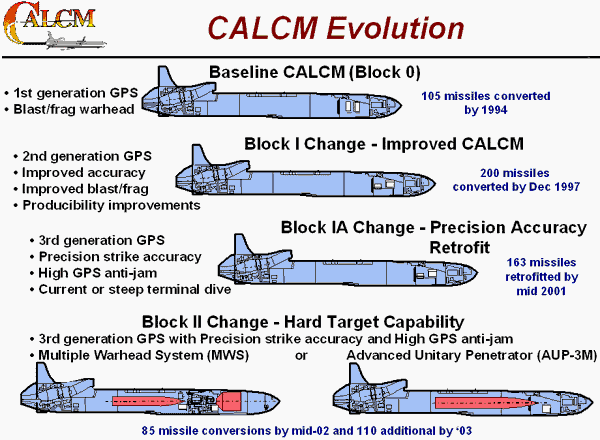
All told, the JASSM-XR promises longer legs than the CALCMs, but with a smaller payload capacity by weight compared to the AGM-86C specifically. At the same time, improvements in conventional warhead design, offering greater lethality in smaller packages, which you can read about in greater detail in this past War Zone story, could help mitigate the use of a physically smaller warhead.
It also presents a much lower risk and faster track to acquiring a replacement for the AGM-86C/D than a conventional variant of the LRSO. In addition, it’s interesting to note that technically, having retired the CALCMs before the formal passage of Fiscal Year 2020 NDAA, the Air Force is already in violation of the law, which presently demands that the service reach initial operational capability with a conventional LRSO variant before getting rid of those missiles. This strongly indicates Congress’ decision was based, at least in part, on information it received on the progress of the JASSM-XR program or other alternatives.
A conventional cruise missile design with a smaller form factor than the AGM-86C/D could also provide increased flexibility in terms of the launch platform. For some time now, the Air Force’s B-52 bombers have been the only aircraft certified to carry any variant of the AGM-86. One potential new launch platform for a future CALCM replacement could be the B-1B bomber, which is already certified to carry the JASSM and JASSM-ER. The Air Force has recently been experimenting with ways to increase its ordnance carrying capabilities, which you can read about in this previous War Zone piece.
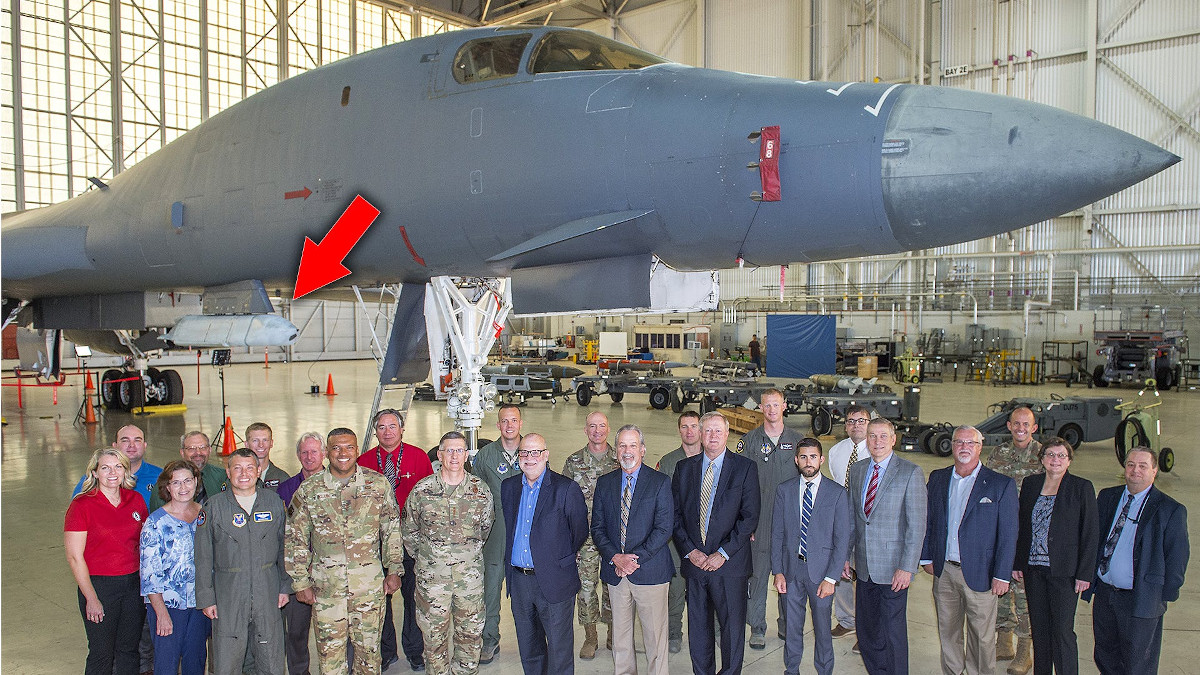
Beyond practical factors, there had been critics of the conventionally-armed LRSO who had warned that there were risks of potential opponents mistaking incoming conventional missiles for nuclear ones and responding accordingly and who are now likely to be placated by this decision. It’s worth noting, however, the Air Force had already employed CALCMs on multiple occasions since those weapons first entered service in 1991 without any such issue.
A conventional air-launched cruise missile to replace the AGM-86C/D, whether its the JASSM-XR or another design, could also have sea- and ground-launched applications, as well. The Navy is presently refining its requirements for a Next Generation Strike Weapon (NGSW) that could replace the venerable BGM-109 Tomahawk land-attack cruise missile and the U.S. Army is now in the market for a ground-launched cruise missile following the collapse of the Intermediate-Range Nuclear Forces Treaty, or INF, between the United States and Russia, which had prohibited weapons in this class with ranges between 310 and 3,420 miles, earlier this year.
In August 2019, the U.S. military launched a Tomahawk from a trailer-mounted version of the Mk 41 Vertical Launch System found on various U.S. and foreign naval vessels. Lockheed Martin has already designed its AGM-158C Long Range Anti-Ship Missile (LRASM), an anti-ship derivative of the JASSM, to work with the Mk 41 and it is possible that the JASSM-XR could work with those launchers, too. This wouldn’t preclude the development of new, dedicated launchers, as well.

All told, the removal of a Congressional requirement for a conventional variant of the LRSO could open the door to alternative designs, including ones that could find their way into ground- and sea-based launchers, as well as getting air-launched from aircraft.
Contact the author: joe@thedrive.com
